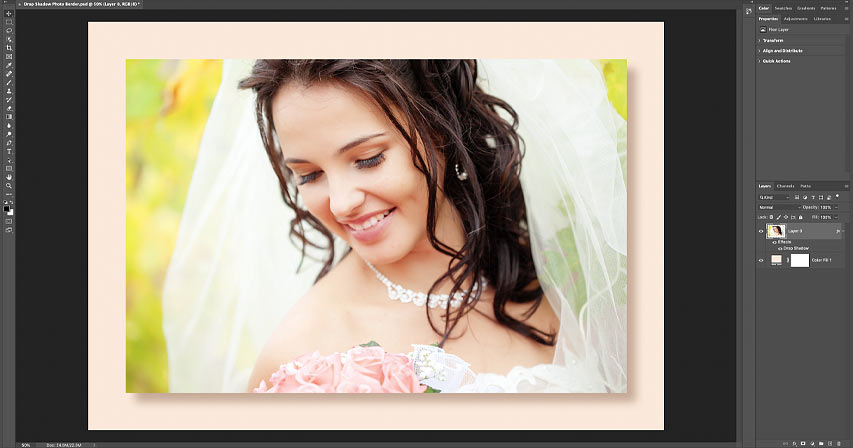

Learn how easy it is to add a photo border and a drop shadow to an image with Photoshop! A step-by-step tutorial for Photoshop 2021 and earlier.
Written by Steve Patterson.
In this tutorial, I show you how to add canvas space and a drop shadow to an image in Photoshop to create a simple yet stylish photo border. We start by creating the basic effect using a white border and a black shadow. And then I show you how to customize the effect by choosing a border and shadow color directly from the image itself.
You can follow along with any version of Photoshop. I’m using Photoshop 2021.
Here’s what the result will look like with a white border and a black drop shadow:

The main border and shadow effect.
And here’s the result using a custom border and shadow color sampled from the image:

The custom border and shadow effect.
Let’s get started!
Step 1: Open your image into Photoshop
Start by opening your image. I’ll use this image from Adobe Stock:

The original photo. Credit: Adobe Stock.
Related: How to get your images into Photoshop
Step 2: Unlock the Background layer
In the Layers panel, the image appears on the Background layer. And at the moment, the Background layer is locked, indicated by the lock icon to the right of the layer’s name:

Photoshop’s Layers panel.
To place a border around the image, we need to add a new layer below it. But we can’t do that while the Background layer is locked. So to unlock it, click the lock icon.
Or if you’re using an older Photoshop version and clicking the lock icon doesn’t work, press and hold the Alt (Win) / Option (Mac) key on your keyboard and double-click the lock icon:

Unlocking the Background layer.
Photoshop renames the layer from Background
to Layer 0
, and the lock icon disappears:

The Background layer has been renamed and unlocked.
Step 3: Add a Solid Color fill layer
To create the photo border, we’ll use a Solid Color fill layer.
Click the New Fill or Adjustment Layer icon at the bottom of the Layers panel:
![]()
Clicking the New Fill or Adjustment Layer icon.
And choose Solid Color from the list:

Adding a Solid Color fill layer.
Then in the Color Picker, choose white by setting the R, G and B values to 255. We’ll use white as the border color for now, but I’ll show you how to change it later. Click OK when you’re done:

Choosing white from Photoshop’s Color Picker.
Back in the document, the white from the fill layer temporarily blocks the image from view:

The result after adding the Solid Color fill layer.
Step 4: Move the fill layer below the image
To fix that, click on the Solid Color fill layer in the Layers panel and drag it below the image:

Dragging the fill layer below the image layer.
Release your mouse button to drop it into place:

The fill layer is now below the image.
And now we’re back to seeing the image, with the fill layer hiding behind it:

The photo is once again visible.
Step 5: Open the Canvas Size dialog box
Next, we need to add more canvas space around the image. The extra space will become the border. And since we’ll want the size of the border to be the same on all four sides, the best way to do it is with Photoshop’s Canvas Size command.
Go up to the Image menu in the Menu Bar and choose Canvas Size:

Going to Image > Canvas Size.
Step 6: Increase the width and height of the canvas
In the Canvas Size dialog box, click the Relative option. This tells Photoshop to start with the current canvas size, and the values we enter for the Width and Height will be added to it.
In the Anchor grid, make sure the center box is selected so that the extra space will be added evenly on the top, bottom, left and right:

Selecting the Relative option and the center Anchor box.
Then enter a size for the border into the Width and Height fields. But keep in mind that the values you enter will be divided equally between two sides. So for example, entering 2 inches for the Width will result in a 1 inch border on the left and right of the photo. And entering 2 inches for the Height will give you a 1 inch border on the top and bottom.
For my image, a 1 inch border will be a bit too wide. A 3/4 inch border will look better. So to add a 3/4 inch border on the left and right of the photo, I need to set the Width to twice that amount, which is 1.5 inches. And to keep the border the same size all around, I’ll set the Height to 1.5 inches as well.
Click OK when you’re done to close the Canvas Size dialog box:

Selecting the Relative option and the center Anchor box.
Photoshop adds the extra canvas space around the image, creating our photo border. Even though the extra space is actually transparent, it appears white because the Solid Color fill layer below the image is showing through:

The photo border appears after adding the canvas space.
How to fit the photo border on the screen
If the border is too big to fit on your screen, go up to the View menu in the Menu Bar and choose Fit on Screen:

Going to View > Fit on Screen.
How to change the border size
The downside to Photoshop’s Canvas Size command is that there’s no way to preview the new size before accepting it. So if the border is too wide or too narrow, go up to the Edit menu and choose Undo Canvas Size:

Going to Edit > Undo Canvas Size.
Then go back to the Image menu, back to Canvas Size, and try again with different Width and Height values:

Going to Image > Canvas Size.
Step 7: Select the image layer
We’ve added the photo border, so now let’s add the drop shadow. In the Layers panel, click on the image layer to select it:

Selecting the image layer.
Step 8: Add a Drop Shadow
Then click the fx icon at the bottom:
![]()
Clicking the layer effects icon.
And choose Drop Shadow from the list:

Clicking the layer effects icon.
Step 9: Adjust the Drop Shadow settings
The options for the Drop Shadow open in Photoshop’s Layer Style dialog box. And the three main options are Angle, Distance and Size. Angle controls the direction of the light source, Distance is how far the shadow extends away from the object, and Size controls the softness of the shadow edges:

The Angle, Distance and Size options.
The Angle and Distance options
The fastest way to set the shadow’s angle and distance is to simply click inside the document, keep your mouse button held down, and drag the shadow to position it. As you drag, the Angle and Distance values in the dialog box will change.
Here I’m dragging the shadow down and to the right:

Dragging the shadow to set the angle and distance.
Or you can enter specific Angle and Distance values. I’ll set the Angle to 135 degrees and the Distance to 80 px. The values you need, especially the Distance and Size (which we’ll look at next), will depend on your image:

Entering Angle and Distance values in the dialog box.
Here’s the result so far:

The result after setting the shadow’s angle and distance.
The Size option
Then increase the Size value to soften the shadow edges. I’ll set mine to 60 px, but again it will depend on your image:

Setting the Size value.
And here’s the result with the edges now softer:

The shadow edges are now softer.
The Opacity option
You can also adjust the intensity of the shadow using the Opacity slider. Higher opacity values darken the shadow and lower values lighten it. I’ll lower mine to 30 percent:

Lightening the shadow by lowering the Opacity value.
When you’re happy with the results, click OK to close the Layer Style dialog box:

Closing the dialog box.
And here’s the result after lowering the opacity of the shadow:

The initial border and drop shadow effect.
How to customize the border and shadow colors
At this point, the main effect is done. We’ve added the border around the photo and the drop shadow behind it. But instead of using a white border and a black shadow, we can customize the effect by choosing colors directly from the image. Here’s how to do it.
Step 10: Double-click the fill layer’s color swatch
To change the border color, double-click on the fill layer’s color swatch in the Layers panel:

Double-clicking the color swatch.
Step 11: Sample a new border color from the image
This re-opens the Color Picker. But instead of choosing a new color from the Color Picker itself, move your mouse cursor over the image and click on a color to sample it.
I’ll click on the woman’s shoulder:

Sampling a color for the border from the image.
The color you sampled instantly becomes the new border color. You can keep clicking on different areas of the image to find the color that works best. When you’re done, click OK to close the Color Picker.
Here’s my result with the border set to the new color:

The result with the custom photo border color.
Step 12: Re-open the Drop Shadow settings
Then to choose a new color for the shadow, double-click on the Drop Shadow layer effect below the image layer:

Double-clicking on the words Drop Shadow
.
And in the Layer Style dialog box, click the shadow’s color swatch:

Clicking the Drop Shadow color swatch.
Step 13: Sample a new shadow color from the image
When the Color Picker opens, move your mouse cursor over the image and click on a color to sample it. I’ll click again on the woman’s shoulder:

Sampling a color for the shadow from the image.
Step 14: Adjust the color’s brightness and saturation
Shadow colors need to be dark and highly saturated. So before closing the Color Picker, increase the color’s Saturation (S) value to 100 percent, or close to it.
Then darken the color by lowering its Brightness (B) value. I’ll lower mine to 30 percent to keep the shadow from looking too dark, but you may want to darken it even more depending on your image:

Increasing the saturation and lowering the brightness of the sampled color.
Click OK to close the Color Picker, and we’re done! Here’s my final result using the custom border and shadow colors:

The final result.
Where to go next…
And there we have it! That’s how easy it is to add a simple photo border and a drop shadow to an image with Photoshop!
For another simple photo border effect, see my how to add a border to a photo tutorial. Or for something more artistic, learn how to create a painted edges photo border. Visit our Photo Effects section for more great tutorial ideas. And don’t forget, all of our tutorials are available to download as PDFs!
Source: PhotoshopEssentials
